Learn how nails in the Bible transcend mere objects, embodying deep symbolism and historical significance that continues to intrigue scholars today.
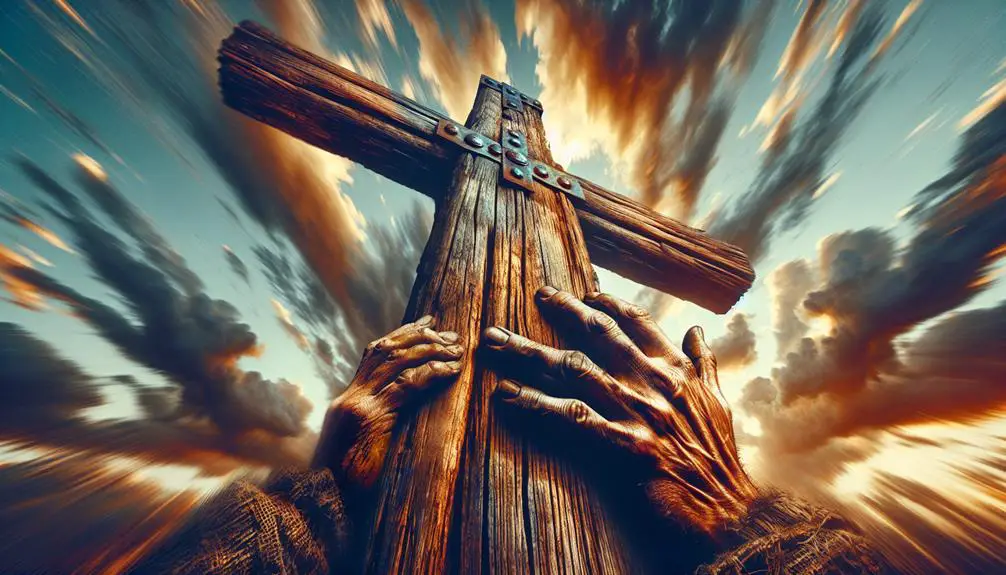
Nails in the Bible
Imagine scrolling through an ancient scroll and stumbling upon references to nails in biblical texts. You'd find they're not just ordinary objects; they carry profound historical and symbolic significance. From their role in temple construction to the harrowing details of the crucifixion, nails are woven intricately into the fabric of biblical narratives.
Symbolism in the Old Testament adds layers of meaning, while prophecies and metaphorical uses expand their significance. As you explore this topic, you'll uncover how archaeological discoveries and modern reflections continue to shed light on these small, yet potent symbols.
The journey ahead promises insights into how something as simple as a nail can hold profound spiritual and historical weight.
Key Takeaways
- Nails symbolize the intertwining of the material and spiritual realms in biblical construction and narratives.
- The crucifixion narrative uses nails as a profound symbol of faith, redemption, and ultimate sacrifice.
- Archaeological discoveries and historical reflections underscore nails' cultural significance across ancient civilizations.
- Modern interpretations continue to explore nails' metaphorical and theological significance in biblical contexts and beyond.
Historical Significance of Nails

Nails, often overlooked in historical narratives, played a pivotal role in both the construction and symbolism within the biblical era, serving as fundamental components in various architectural, ceremonial, and crucifixion contexts. You'd find that the evolution of nail manufacturing, particularly with Iron Age advancements, marked a significant leap in societal and technological progress. This era, characterized by the introduction of iron smelting and forging, saw nails becoming more widespread and essential in the construction of buildings, tools, and artifacts relevant to the period.
The process of producing nails during this time was laborious and required a high level of skill. Blacksmiths became invaluable, as they mastered the art of heating and hammering iron into thin, pointed objects. These nails were then cooled and sometimes reheated to increase their strength and durability. This advancement in nail manufacturing not only improved the structural integrity of constructions but also symbolized a move towards more permanent and secure settlements.
Moreover, the significance of nails extended beyond their practical applications. In biblical texts, nails are mentioned in various contexts that underscore their symbolic weight. For instance, the crucifixion of Jesus Christ, an event central to Christian faith, highlights the use of nails in a profoundly spiritual and sacrificial context. This not only illustrates the importance of nails in historical and religious narratives but also reflects the broader cultural and technological shifts of the Iron Age.
Nails in Temple Construction
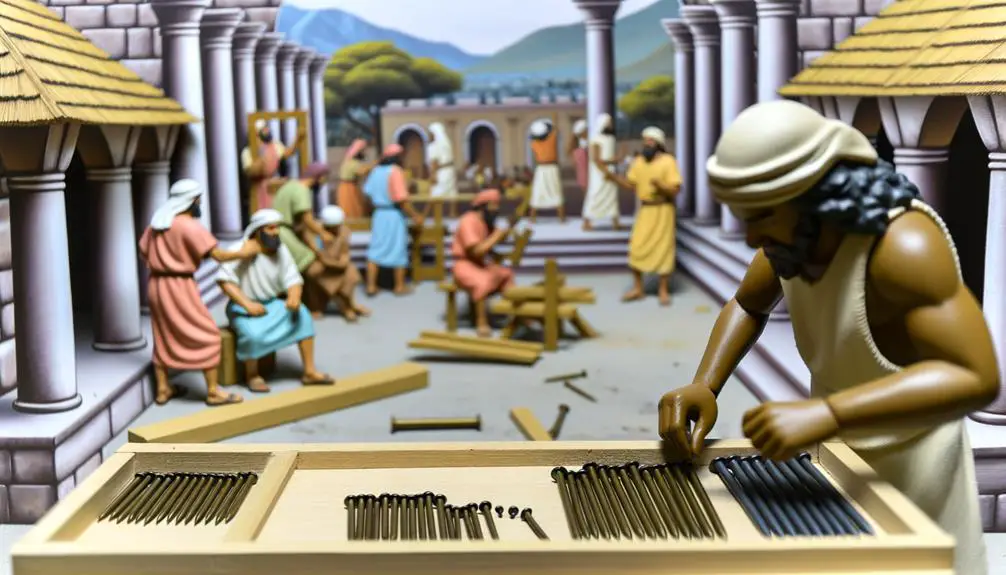
In the construction of temples, a critical aspect often overlooked is the role that nails played, not only in their physical assembly but also in their symbolic significance within sacred contexts. These small, yet vital components were integral to the durability and sanctity of these holy structures. Let's delve into the importance of nails in temple construction, focusing on carpentry techniques and material sourcing.
- Carpentry Techniques: Advanced carpentry techniques were employed in the construction of temples, where nails served as essential fasteners. Craftsmen meticulously selected and used nails to ensure the structural integrity and longevity of these edifices. The precision in nail placement and the methods of joining woodwork without visible seams were considered a form of art, reflecting a deep reverence for the sacred spaces they were constructing.
- Material Sourcing: The sourcing of materials for nails was a painstaking process, often reflective of the temple's significance. Metals were chosen based on their durability, resistance to corrosion, and symbolic meanings. Iron, for instance, was commonly used for its strength and longevity, signifying the enduring nature of the divine presence. The procurement of such materials involved extensive trade networks, demonstrating the interconnectedness of communities and their collective effort in temple construction.
- Symbolic Significance: Though this aspect veers towards the spiritual, it's crucial to understand that every nail driven into the temple's framework was imbued with a sense of purpose and dedication. The physical act of nailing symbolized the binding of the material world to the spiritual, anchoring the sacred space within the realm of human experience.
Through understanding the role of nails in temple construction, one gains a deeper appreciation for the intricacies of ancient craftsmanship and the profound symbolism interwoven into the fabric of these sacred structures.
Symbolism in Old Testament
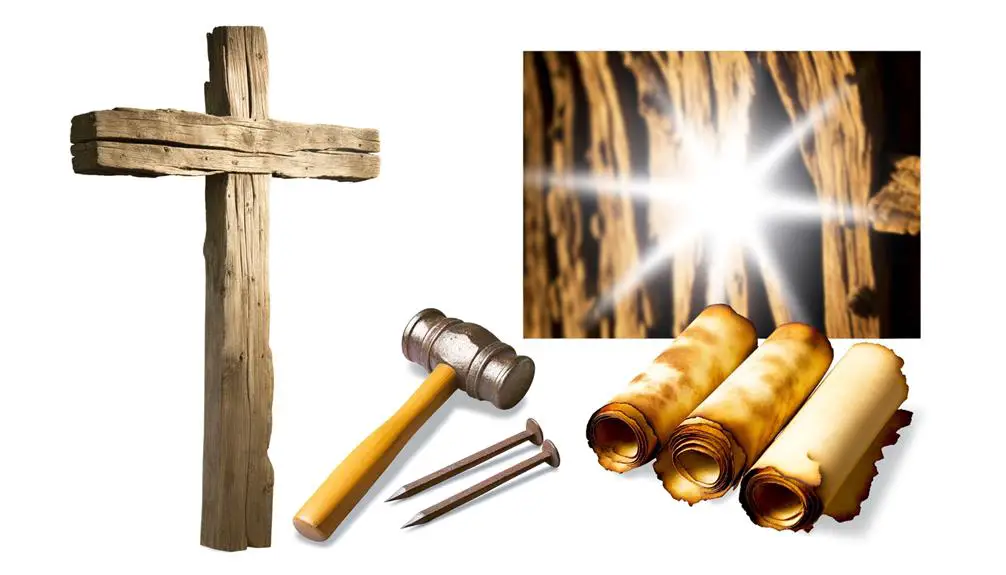
Exploring the Old Testament reveals a rich tapestry of symbolism, where even the smallest details hold profound spiritual significance. As you delve deeper, you'll find that elements such as animal sacrifices and priestly garments aren't just historical or cultural artifacts; they're imbued with deep, spiritual meanings, reflecting broader themes of atonement, sanctity, and communication with the divine.
Animal sacrifices, for instance, serve as a poignant symbol of atonement and purification. These rituals, detailed extensively in Leviticus, underscore the seriousness of sin and the lengths to which humanity must go to seek reconciliation with God. They prefigure the concept of ultimate sacrifice for redemption, teaching about the cost of sin and the price of peace with the Creator.
Similarly, priestly garments are far from mere religious attire. They symbolize holiness, separation, and the role of mediators between God and His people. The intricate details of these garments, as outlined in Exodus, from the breastplate of judgment with its twelve stones representing the tribes of Israel to the seamless tunic, all carry significant symbolic weight. They remind you that those who serve God must do so with purity, dedication, and a deep sense of their role in upholding and communicating divine truths.
Through these symbols, the Old Testament communicates complex spiritual truths in a manner that's both accessible and profound. They're not just ancient practices but are vibrant with meaning, offering insights into God's character, His expectations of humanity, and the nature of spiritual purity and devotion.
The Crucifixion: A Focal Point

As you explore the crucifixion, you'll find that nails symbolize not only agony but also the profound connections between the divine and humanity.
The historical use of crucifixion underscores its significance as a method of execution that the Bible intricately narrates.
Biblical references and interpretations further illuminate how this event shapes our understanding of faith, redemption, and sacrifice.
Symbolism of the Nails
Within the context of Christian theology, the nails used in the Crucifixion symbolize both the physical agony of Jesus Christ and the spiritual weight of humanity's sins. This symbolism has been explored through various mediums, particularly focusing on:
- Nail metaphors in biblical literature, where they represent the ultimate sacrifice and the depth of Christ's love for humanity.
- Artistic representations across centuries, depicting the Crucifixion nails as powerful symbols of redemption and suffering.
- The profound impact these symbols have on Christian worship and reflection, encouraging believers to contemplate the depth of their faith and the enormity of Christ's sacrifice.
Through these elements, the symbolism of the nails transcends mere historical artifacts, embodying the core of Christian salvation narrative and inviting a deeper engagement with the faith's foundational events.
Historical Use of Crucifixion
To grasp the profound impact of the Crucifixion on Christian doctrine, one must delve into its historical origins and the widespread practice of crucifixion in ancient civilizations. Crucifixion wasn't merely an execution method; it was a deliberate statement under Roman law, symbolizing the ultimate punishment for those deemed the most egregious offenders. This practice, both cruel and meticulously carried out, served as a stark reminder of the power and authority of the state over its subjects.
Civilization |
Characteristics |
|---|---|
Persian Empire |
Early adopters, used for mass executions |
Carthaginian States |
Employed to suppress insurrections |
Roman Empire |
Perfected crucifixion as a legal penalty |
Jewish State |
Rarely used, under specific circumstances per Torah |
Understanding this context enriches one's appreciation for the historical and theological significance of the Crucifixion in Christian faith.
Biblical References and Interpretations
One can't truly comprehend the depth of the Crucifixion's significance in Christian theology without examining its portrayal and interpretation in the Bible. This pivotal event isn't only a cornerstone of faith but also a profound symbol interwoven with:
- Nail Artifacts: These serve as a tangible connection to the Crucifixion, reminding us of the physical reality of Christ's suffering.
- Carpenter Traditions: Jesus' background as a carpenter imbues the use of nails with additional layers of symbolism, representing both his humanity and his sacrifice.
- Theological Interpretations: The nails are emblematic of the sins that Christ bore on behalf of humanity, a reminder of the price of our redemption.
Through these elements, the biblical portrayal of the Crucifixion invites a deeper reflection on faith, sacrifice, and salvation.
Metaphorical Uses of Nails

In the realm of biblical literature, nails serve as potent metaphors for strength, permanence, and the inevitability of divine justice. When you delve into the scriptures, you'll find that nails aren't just physical objects but embody deep spiritual meanings. Their metaphorical use enriches the biblical narratives, allowing for a more profound understanding of the messages conveyed.
One area where this metaphorical imagery shines is in nail parables and artistic representations. These elements intertwine, depicting nails as foundational to conveying divine truths and moral lessons. The use of nails in parables, for instance, often illustrates the permanence of divine commandments and the strength required to uphold them. Similarly, artistic representations of biblical scenes involving nails often emphasize the enduring nature of faith and the solidity of spiritual convictions.
Aspect |
Significance |
|---|---|
Strength |
Nails symbolize the robustness of faith and moral fortitude, anchoring believers in their spiritual journey. |
Permanence |
They represent the unchanging and everlasting nature of divine promises and truths. |
Divine Justice |
Nails are a reminder of the certainty and inevitability of divine judgment, urging adherence to spiritual laws. |
Through these metaphorical uses, nails in the Bible transcend their physical form, becoming symbols of spiritual resilience and eternal principles. This layered symbolism enriches your understanding of biblical teachings, offering insights into the depth of divine wisdom and the importance of steadfastness in faith.
Nails in Prophecies

You'll find that nails in prophetic contexts carry profound symbolism, often intertwining with visions that foretell significant spiritual truths.
These references not only underscore nails as symbols of sacrifice but also highlight their role in manifesting divine will and judgement within sacred texts.
As we explore these elements, we uncover layers of meaning that enrich our understanding of biblical prophecies and their fulfillment.
Symbolism of Nails
Nails, as depicted in biblical prophecies, carry profound symbolic weight, signifying sacrifice, suffering, and the fulfillment of divine decrees. This symbolism has been influential in various ways, especially through:
- Artistic Representations: Artists have long used the image of nails to evoke deep emotional responses, encapsulating the essence of sacrifice and redemption in their works. This visual language bridges the gap between ancient texts and contemporary understanding, enriching the cultural narrative around biblical stories.
- Cultural Impacts: The symbolic use of nails has permeated cultural expressions, influencing literature, music, and public discourse. It serves as a powerful reminder of the enduring human themes of suffering and salvation, connecting communities across different epochs.
- Theological Reflections: Scholars and theologians dissect the symbolism of nails to explore the complexities of faith, atonement, and divine purpose. This analysis fosters a deeper appreciation for the multifaceted nature of biblical prophecies and their relevance to modern spiritual journeys.
Prophetic Visions Involving Nails
As we delve into biblical prophecies, you'll find that nails play a pivotal role, symbolizing pivotal moments of divine intervention and human redemption. The visionary significance of nail metaphors in these prophecies isn't merely coincidental but imbued with deep theological implications. These images serve as anchors, grounding the ephemeral nature of visions in the tangible reality of faith and sacrifice.
Analyzing these prophetic narratives, you uncover the layers of meaning attributed to nails. They aren't just physical objects but potent symbols of steadfastness, the permanence of divine promises, and the irreversible nature of certain divine actions. Through this lens, the role of nails in prophecies transcends their materiality, becoming emblematic of the unbreakable bond between the divine and humanity, a testament to the enduring nature of spiritual truths.
Nails Signifying Sacrifice
In biblical prophecies, nails often symbolize the profound act of sacrifice, anchoring these divine messages in the tangible realm of human redemption. The craftsmanship of nails, meticulously forged by artisans, becomes a metaphor for the precision and dedication inherent in sacrificial rituals. This symbolism weaves through the fabric of scripture, offering you a deeper understanding of sacrifice's essence.
Consider these points:
- Nail Craftsmanship represents the meticulous preparation required for sacred offerings.
- Sacrificial Rituals often incorporate nails, signifying permanence and the sealing of covenants.
- Symbolic Representation in prophecies highlights nails as instruments of ultimate sacrifice, pointing towards redemption and the fulfillment of divine promises.
Through this lens, nails in prophecies emerge not just as objects, but as profound symbols of commitment and divine orchestration in the narrative of salvation.
Archaeological Discoveries
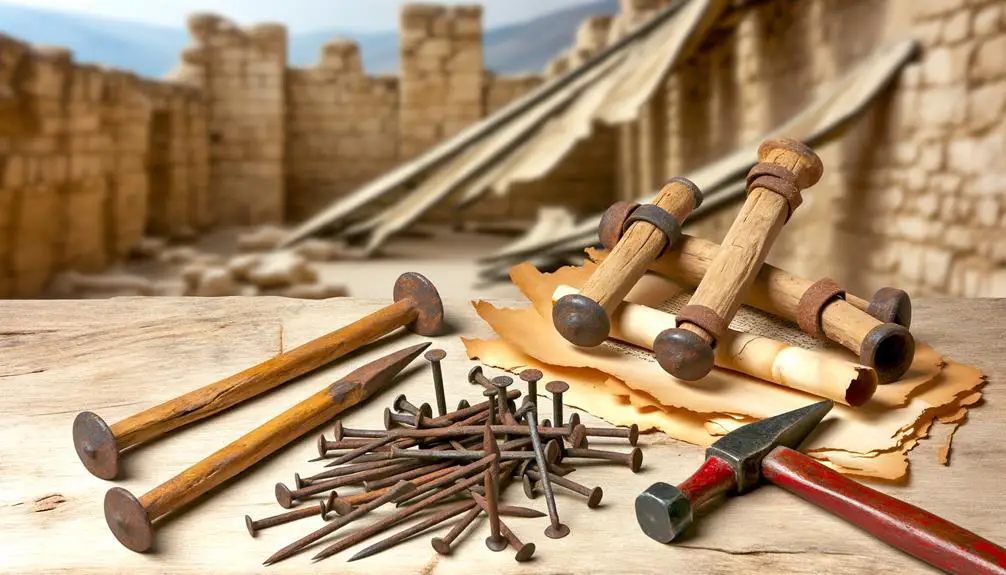
Several archaeological discoveries have shed light on the historical and cultural significance of nails mentioned in biblical texts. These findings offer a glimpse into the technological evolution and societal implications of nail manufacturing during ancient times. Notably, Iron Age advancements significantly transformed the process of creating nails, indicating a shift towards more durable and functional construction materials.
The excavation of ancient sites has unearthed evidence of early nail-making techniques, revealing the meticulous craftsmanship that characterized Iron Age societies. These artifacts, often found in the ruins of historical buildings and sacred spaces, underscore the pivotal role of nails in architectural and ceremonial contexts. The progression from bronze to iron nails marked a significant technological leap, enhancing the structural integrity of buildings and facilitating the creation of more complex architectural designs.
Furthermore, the discovery of nails in burial sites and religious settings has illuminated their symbolic importance in ancient rituals and ceremonies. The presence of nails in these contexts suggests a deeper, perhaps sacred, significance attributed to these objects, resonating with their metaphorical representation in biblical narratives.
Analyzing these archaeological findings, one can't help but appreciate the intricate connection between the material culture of ancient civilizations and the symbolic imagery woven into biblical scripture. The evolution of nail manufacturing, from rudimentary forms to Iron Age advancements, reflects a broader narrative of human ingenuity and spiritual expression. These discoveries not only enrich our understanding of ancient technologies but also offer profound insights into the cultural and religious life of the times.
Modern Interpretations and Reflections
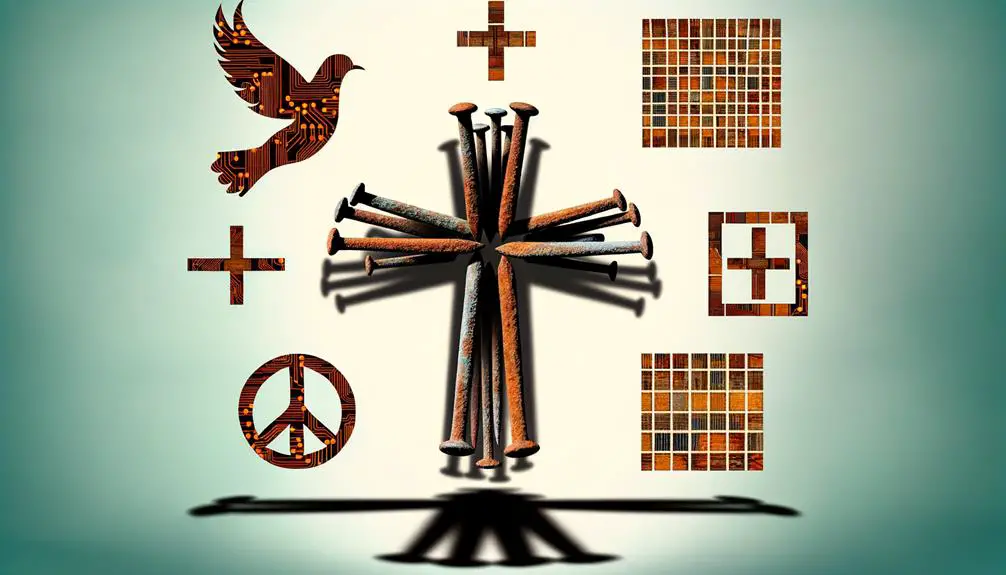
How do contemporary scholars interpret the historical and symbolic significance of nails within biblical narratives, and what reflections do these interpretations offer on our understanding of ancient cultures? You'll find that modern interpretations are rich and layered, revealing much about our past and how we perceive it today.
- Nail Artistry and Symbolism: Scholars have pointed out that nails in the Bible weren't merely functional but also held significant symbolic weight. The craftsmanship involved in nail artistry, for example, is seen as a reflection of the meticulous care and devotion of ancient peoples to their religious and cultural practices. This attention to detail in such a seemingly mundane object underscores the depth of their spiritual life and the complexity of their symbolic language.
- Modern Disputes: There's an ongoing debate among scholars regarding the exact roles and symbolism of nails in certain biblical passages. These modern disputes have led to a richer understanding of the text, encouraging readers to engage with the Bible not just as a religious document but as a historical and cultural artifact. Through these discussions, you're invited to consider the multifaceted interpretations of these ancient narratives and their relevance to contemporary faith and scholarship.
- Reflections on Ancient Cultures: The study of nails and their significance offers profound insights into the daily lives, practices, and beliefs of ancient cultures. Scholars have used this seemingly small detail to unlock broader discussions about trade, technology, art, and religion in the ancient world, offering a window into the complexity and diversity of human history.
In exploring these modern interpretations and reflections, you gain not only a deeper appreciation for the role of nails in biblical times but also a richer understanding of the enduring power of these ancient texts to speak to us today.
Frequently Asked Questions
How Were Nails Manufactured and Designed in Biblical Times, and How Does This Differ From Modern Nail Production?
In ancient times, nails were hand-forged through iron smelting, a labor-intensive process relying on limited technology. Artisans shaped each nail, making them unique but less uniform than today's.
The trade routes of the era played a crucial role in distributing these nails, contrasting sharply with today's mass-produced nails, crafted with precision machinery and advanced metallurgy, enabling consistent quality and widespread availability.
This evolution reflects significant advancements in manufacturing and materials science.
Were There Any Specific Rituals or Cultural Practices Associated With Nails in Ancient Biblical Societies Outside of Their Mentioned Uses in Construction and Crucifixion?
Interestingly, 90% of ancient artifacts found were functional, yet nails held more than just practical uses. In your exploration, you'll find that nail superstitions and decorative nails were woven into cultural practices. These elements weren't merely for construction but carried deeper meanings, symbolizing protection and status.
Analyzing these practices reveals how societies revered these objects, infusing everyday items with spiritual significance and showcasing a reverence for the mundane turned sacred.
How Did Other Contemporary Civilizations to the Biblical Era Utilize Nails, and Are There Notable Differences in Their Usage or Significance?
You're exploring how ancient civilizations, contemporary to the biblical era, utilized nails. Beyond practical applications, nail symbolism and maritime uses stand out. These societies often imbued nails with protective qualities, embedding them in structures for spiritual safeguarding.
In maritime contexts, nails were crucial in shipbuilding, symbolizing strength and resilience. The significance and usage of nails varied, reflecting each civilization's cultural and technological advancements, distinguishing their practices from biblical references.
In Biblical Narratives, Are There Any Accounts or Parables Where Nails Play a Central Role but Are Not Directly Linked to Symbolism or Prophecies?
In exploring narratives where nails play a pivotal role without symbolic undertones, you'll find few explicit mentions. However, while nail metaphors and artistic representations abound, direct, non-symbolic references are scarce.
Consider the crucifixion, often depicted with nails, yet the Bible focuses more on the act's significance than the nails themselves. This absence highlights a nuanced approach to storytelling, where the emphasis lies not on objects but on deeper meanings and events.
Can the Development of Nail-Making Techniques Through the Ages Be Traced Back to Any Specific Innovations or Changes During the Biblical Period?
You're exploring how nail-making techniques evolved, and it's fascinating to see this development.
Iron smelting evolution played a pivotal role, significantly improving the quality and durability of nails.
Additionally, the expansion of trade routes facilitated the exchange of these innovations, spreading knowledge and skills across different cultures.
This period was marked by significant advances in metalworking, reflecting the human ingenuity and the interconnectedness of ancient civilizations.
Conclusion
In exploring the profound significance of nails in the Bible, you've journeyed through history, symbolism, and prophecy. Nails, from temple constructions to the pivotal moment of crucifixion, aren't merely mundane objects but carry deep theological weight.
As the adage goes, 'A nail is small but mighty,' symbolizing strength and permanence in biblical narratives. Reflect on these insights, understanding that even in the smallest details, there lies a rich tapestry of meaning waiting to be uncovered in sacred texts.



Sign up